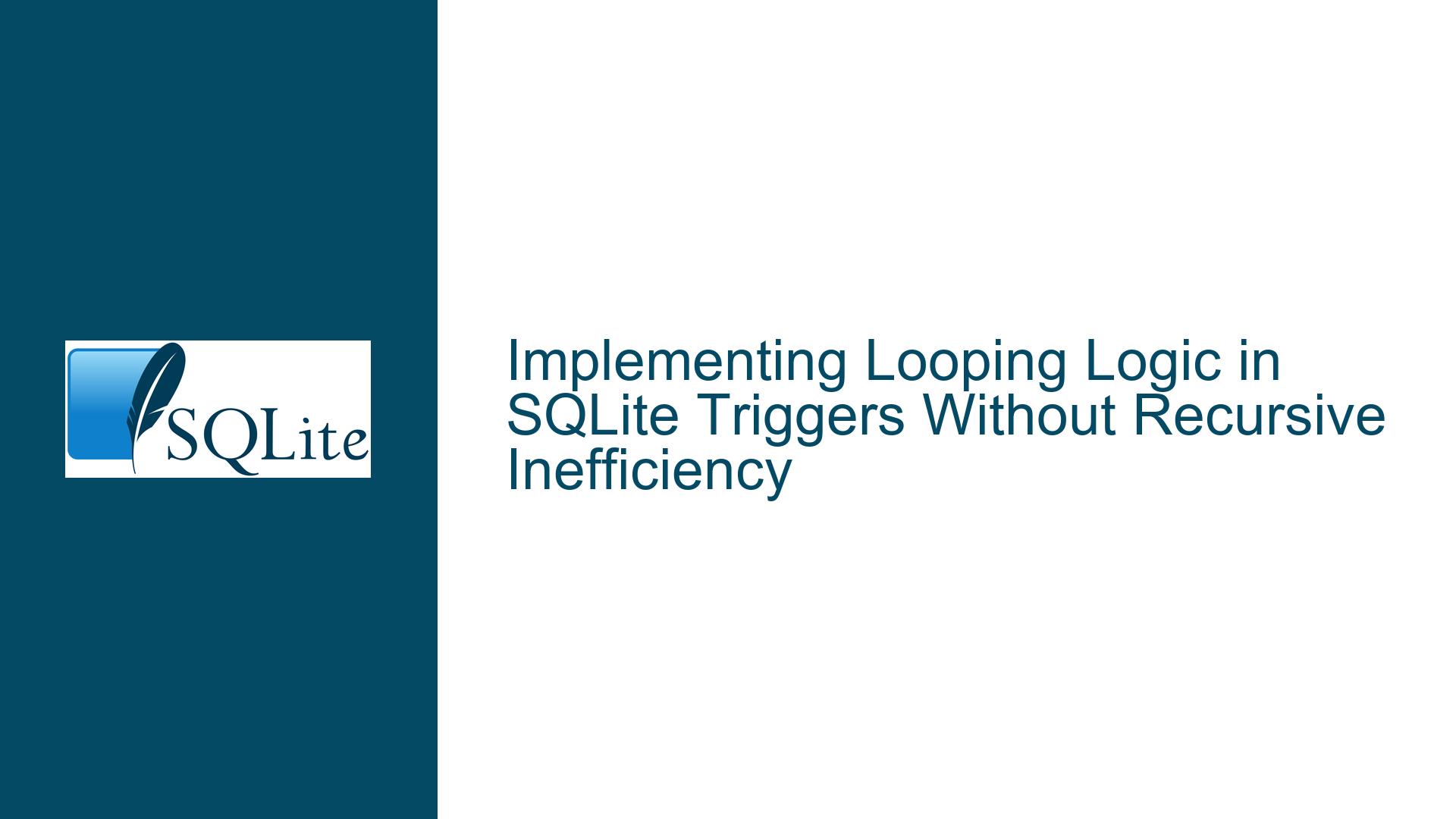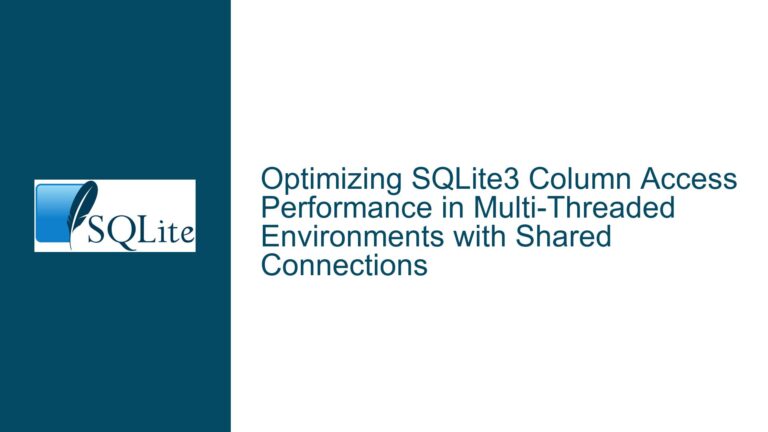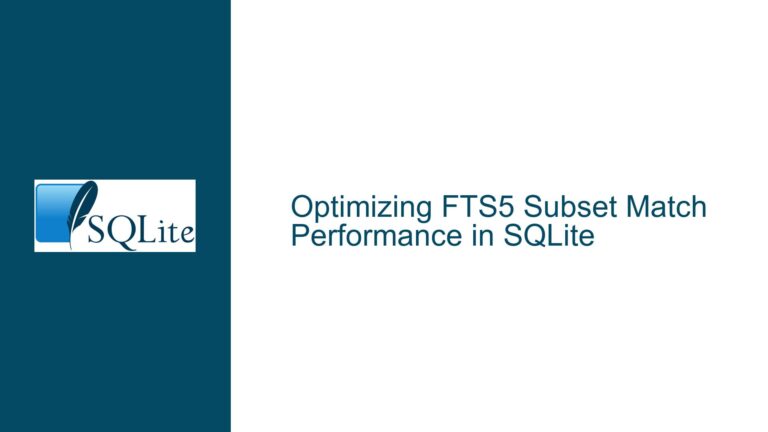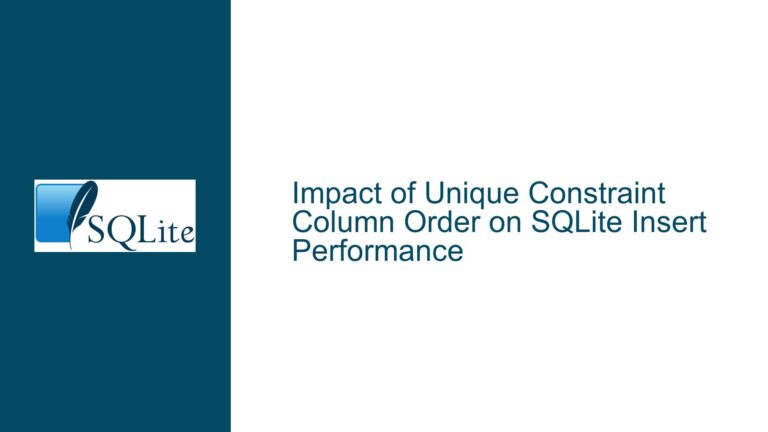Implementing Looping Logic in SQLite Triggers Without Recursive Inefficiency
Understanding Trigger-Based Data Management and the Absence of Explicit Loops
Issue Overview
The central challenge arises when developers attempt to enforce data constraints that require iterative processing within SQLite triggers. A canonical example involves maintaining a rolling data cap (e.g., ensuring a table never exceeds 10MB of data) by deleting the oldest records when new entries push the total beyond the threshold. The initial approach uses recursive triggers activated after INSERT/DELETE operations:
CREATE TRIGGER less_den_ten_mb_after_insert AFTER INSERT ON mqtt6
WHEN (SELECT sum(size_t) > 10240000 FROM mqtt6)
BEGIN
DELETE FROM mqtt6 WHERE timestamp = (SELECT min(timestamp) FROM mqtt6);
END;
CREATE TRIGGER less_den_ten_mb_delete AFTER DELETE ON mqtt6
WHEN (SELECT sum(size_t) > 10240000 FROM mqtt6)
BEGIN
DELETE FROM mqtt6 WHERE timestamp = (SELECT min(timestamp) FROM mqtt6);
END;
PRAGMA recursive_triggers = 1;
This setup creates a cascading effect: Each DELETE operation might re-trigger the same logic until the sum of size_t falls below the threshold. While functionally correct, this method suffers from two critical flaws:
- Performance Degradation: Each trigger activation incurs full-table scans to compute
sum(size_t)and locate the oldest record. With large datasets, this becomes prohibitively slow. - Recursive Overhead: Even with
recursive_triggersenabled, SQLite’s trigger stack limits and the lack of tail recursion optimization lead to unnecessary context switches and temporary table operations.
The problem is exacerbated by SQLite’s design philosophy, which intentionally omits stored procedures and explicit loop constructs (FOR, WHILE). Developers accustomed to procedural languages (e.g., C++/Python) often seek analogous looping mechanisms, unaware that SQL’s declarative paradigm requires fundamentally different approaches.
Root Causes of Inefficiency and Workaround Limitations
1. SQLite’s Trigger Execution Model and Recursion Constraints
SQLite triggers operate within a restricted execution environment:
- Single-Statement Activation: Each trigger body executes as a single atomic operation. Looping logic must be implemented through recursive trigger calls or CTEs (Common Table Expressions), not procedural loops.
- Recursive Trigger Pragmas: Enabling
PRAGMA recursive_triggerspermits a trigger to fire again due to changes made by its own execution. However, this is not true recursion with stack frames; it’s a re-entrant execution that shares the same environment, leading to hidden state mutations and unpredictable performance.
2. Misuse of Aggregation in Conditional Checks
The WHEN clause in the original triggers recalculates sum(size_t) after every INSERT/DELETE. This forces a full table scan each time, negating the benefits of indexing. For tables with millions of rows, this results in O(n) complexity for every trigger invocation.
3. Lack of Bulk Deletion Strategy
Deleting one row at a time (oldest timestamp) when a bulk deletion is possible creates O(n) trigger activations for n rows needing removal. This amplifies transactional overhead, as each DELETE is an independent operation with journaling and index updates.
4. Indexing Misconfiguration
Without a composite index on (timestamp, size_t), the subqueries SELECT min(timestamp) and sum(size_t) resort to full table scans. Even with an index on timestamp, the absence of size_t in the index necessitates lookups in the main table structure, doubling I/O operations.
Optimizing Trigger Logic with Window Functions and Indexed Queries
Step 1: Replace Recursive Triggers with Window-Function-Based Aggregation
The recursive trigger approach is replaced by a single trigger that uses a window function to compute cumulative sums in descending timestamp order. This allows identifying all rows contributing to the threshold breach in one pass:
CREATE TRIGGER optimize_mqtt6_capacity AFTER INSERT ON mqtt6
BEGIN
DELETE FROM mqtt6
WHERE timestamp <= (
SELECT timestamp
FROM (
SELECT timestamp,
sum(size_t) OVER (ORDER BY timestamp DESC) AS cumulative_sum
FROM mqtt6
)
WHERE cumulative_sum >= 10240000
LIMIT 1
);
END;
Key Improvements:
- Single Trigger Activation: Regardless of how many rows exceed the threshold, the trigger fires once per INSERT.
- Window Function Efficiency:
sum(size_t) OVER (ORDER BY timestamp DESC)computes cumulative sums in reverse chronological order. The first row wherecumulative_sum >= 10240000marks the cutoff point; all older rows are deleted. - Elimination of Redundant WHEN Clause: The trigger always executes, but the DELETE becomes a no-op if the threshold isn’t breached, avoiding redundant sum calculations.
Step 2: Index Optimization for Window Functions
Create a composite index covering both timestamp and size_t to enable index-only scans:
CREATE INDEX mqtt6_timestamp_size ON mqtt6 (timestamp DESC, size_t);
This allows the window function’s ORDER BY timestamp DESC to leverage the index for both sorting and summing size_t, reducing computation to O(log n) complexity.
Step 3: Benchmarking and Validation
After deploying the optimized trigger, validate its performance:
-- Populate with test data
INSERT INTO mqtt6
SELECT value, abs(random() % 1024) + 1
FROM generate_series(1, 1000000);
-- Test insert beyond threshold
INSERT INTO mqtt6 VALUES (1000001, 2048);
-- Verify remaining data
SELECT count(*), sum(size_t), min(timestamp), max(timestamp) FROM mqtt6;
Expected Outcome:
- The trigger deletes enough rows in a single operation to bring
sum(size_t)below 10MB. - Query execution time remains consistent even as the dataset grows, due to index-only scans.
Step 4: Handling Edge Cases and Concurrency
- Concurrent Writes: SQLite’s write-ahead logging (WAL) mode allows concurrent reads but serializes writes. Ensure transactions are kept short to avoid lock contention.
- Fragmented Timestamps: If
timestampisn’t monotonically increasing, adjust the window function’sORDER BYclause to use an auto-incrementing primary key instead. - Threshold Precision: When exact size enforcement is critical, replace
>= 10240000with a more precise condition, potentially using a sliding window algorithm.
Step 5: Alternative Approaches for Complex Logic
For use cases requiring multi-step processing (e.g., parsing IP addresses as in the discussion’s _INET_ example), combine triggers with materialized views or temporary tables:
CREATE TRIGGER parse_ip_before_update BEFORE UPDATE OF dcs_uri ON device_com_settings
BEGIN
DELETE FROM _inet_temp;
INSERT INTO _inet_temp
WITH RECURSIVE split(ip_part, remainder) AS (
VALUES ('', NEW.dcs_uri || '.')
UNION ALL
SELECT
substr(remainder, 1, instr(remainder || '.', '.') - 1),
substr(remainder, instr(remainder || '.', '.') + 1)
FROM split
WHERE remainder != ''
)
SELECT ip_part FROM split WHERE ip_part != '';
-- Validate octets
SELECT CASE
WHEN (SELECT ip_part FROM _inet_temp WHERE rowid = 1) NOT BETWEEN 0 AND 255 THEN
RAISE(FAIL, 'Invalid first octet')
-- ... Repeat for other octets
END;
END;
This leverages recursive CTEs for string splitting within a trigger, avoiding procedural loops while maintaining clarity.
Final Recommendations and Best Practices
- Avoid Recursive Triggers for Bulk Operations: They are rarely the optimal solution. Use window functions or CTEs to handle iterative logic in a single pass.
- Index Strategically: Composite indexes aligned with query and window function
ORDER BYclauses are essential for performance. - Profile Trigger Execution: Use
EXPLAIN QUERY PLANto verify index usage and identify full table scans. - Consider Application-Side Logic: For extremely large datasets, offloading aggregation or threshold checks to the application layer might be more efficient, despite breaking encapsulation.
By embracing SQLite’s declarative strengths and avoiding procedural emulation, developers achieve both correctness and scalability in constraint enforcement.






